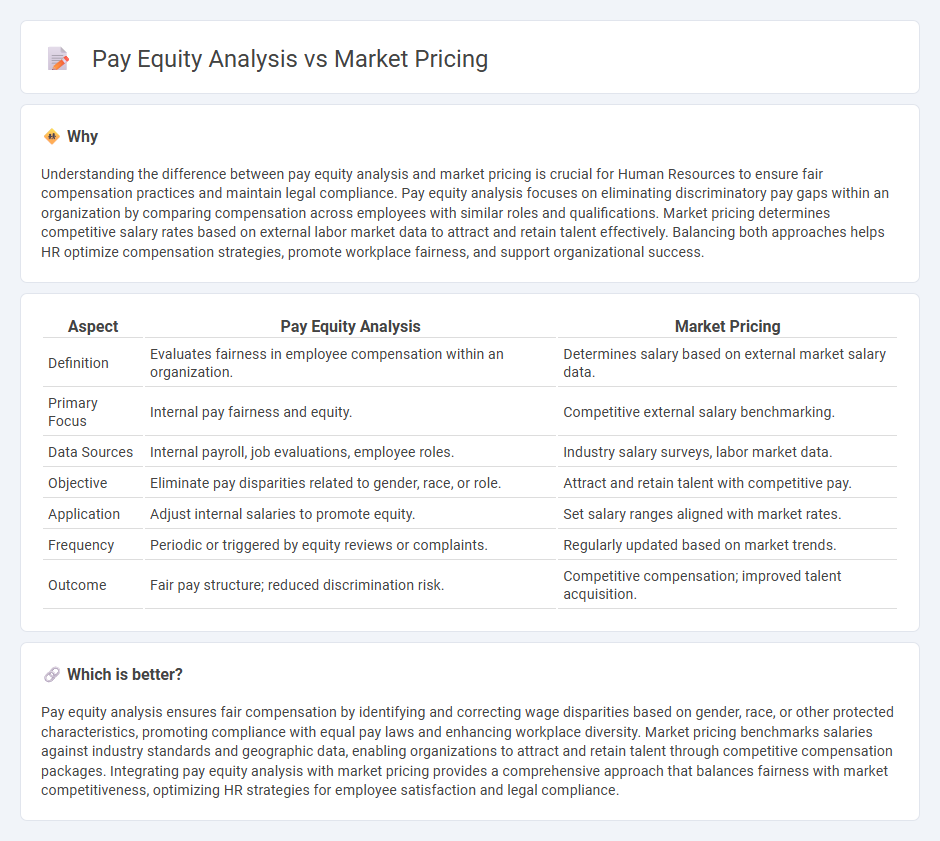
Pay equity analysis ensures fair compensation by assessing internal pay differences and eliminating disparities linked to gender, race, or other protected characteristics. Market pricing involves benchmarking salaries against industry standards to attract and retain top talent while maintaining competitive pay structures. Discover how aligning pay equity with market pricing can optimize your HR strategies for workforce satisfaction and compliance.
Why it is important
Understanding the difference between pay equity analysis and market pricing is crucial for Human Resources to ensure fair compensation practices and maintain legal compliance. Pay equity analysis focuses on eliminating discriminatory pay gaps within an organization by comparing compensation across employees with similar roles and qualifications. Market pricing determines competitive salary rates based on external labor market data to attract and retain talent effectively. Balancing both approaches helps HR optimize compensation strategies, promote workplace fairness, and support organizational success.
Comparison Table
| Aspect | Pay Equity Analysis | Market Pricing |
|---|---|---|
| Definition | Evaluates fairness in employee compensation within an organization. | Determines salary based on external market salary data. |
| Primary Focus | Internal pay fairness and equity. | Competitive external salary benchmarking. |
| Data Sources | Internal payroll, job evaluations, employee roles. | Industry salary surveys, labor market data. |
| Objective | Eliminate pay disparities related to gender, race, or role. | Attract and retain talent with competitive pay. |
| Application | Adjust internal salaries to promote equity. | Set salary ranges aligned with market rates. |
| Frequency | Periodic or triggered by equity reviews or complaints. | Regularly updated based on market trends. |
| Outcome | Fair pay structure; reduced discrimination risk. | Competitive compensation; improved talent acquisition. |
Which is better?
Pay equity analysis ensures fair compensation by identifying and correcting wage disparities based on gender, race, or other protected characteristics, promoting compliance with equal pay laws and enhancing workplace diversity. Market pricing benchmarks salaries against industry standards and geographic data, enabling organizations to attract and retain talent through competitive compensation packages. Integrating pay equity analysis with market pricing provides a comprehensive approach that balances fairness with market competitiveness, optimizing HR strategies for employee satisfaction and legal compliance.
Connection
Pay equity analysis ensures that employees receive fair compensation based on internal roles and responsibilities, while market pricing evaluates external salary benchmarks to align wages with industry standards. Integrating market pricing data into pay equity analysis helps organizations identify and correct compensation disparities, promoting fairness and competitiveness. This connection supports talent retention and attracts diverse candidates by maintaining equitable and market-aligned pay structures.
Key Terms
External Benchmarking
Market pricing uses external benchmarking to set salaries based on competitive pay rates for similar roles in the industry, ensuring compensation aligns with current market trends. Pay equity analysis evaluates internal fairness by comparing employee pay across demographics and job functions to identify and address disparities. Explore detailed strategies and tools to effectively balance market pricing with pay equity analysis for optimal compensation management.
Internal Pay Parity
Market pricing evaluates employee compensation by comparing salaries to external industry standards, ensuring competitiveness in attracting talent. Pay equity analysis examines internal pay parity to identify and correct disparities across employees performing similar roles, promoting fairness and compliance with legal standards. Explore how integrating market pricing with internal pay equity analysis can optimize your compensation strategy for both competitiveness and fairness.
Compensation Structure
Market pricing evaluates employee compensation by comparing salary data from external benchmarks, ensuring competitive pay aligned with industry standards. Pay equity analysis examines internal salary fairness, detecting disparities across employee groups based on gender, race, or role without compromising market competitiveness. Explore our detailed guide to understand how integrating these approaches optimizes your compensation structure.
Source and External Links
What Is Market Pricing? Definition, Advantages and Tips - This article explains market pricing as a strategy to set costs based on competitors' prices, highlighting its advantages in maintaining competitiveness and revenue growth.
What Is Market Pricing? (+ How To Calculate It) - This guide discusses market pricing as setting costs based on competitors, providing a formula to calculate prices and explaining its types.
Compensation Market Pricing Guide - This guide focuses on market pricing in compensation, helping organizations determine fair market values for jobs based on external labor market data.
 dowidth.com
dowidth.com